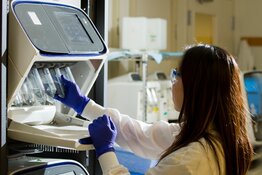The Life Sciences Report: Caroline, broadly speaking you are a medtech analyst, but what specific areas do you cover?
Caroline Corner: I have a full track of names under my umbrella. My coverage includes ophthalmology; ear, nose and throat (ENT); cell therapies and other areas. Ophthalmology includes products that focus on delivery of different therapeutics. It sounds like a lot of spaces, but there is quite a bit of overlap. I cover a lot of technologies that have a device paired with some kind of drug or biologic.
TLSR: You returned to industry for a while, where you were you served as head of investor relations (IR) at a life sciences company, but you came back to equity research. Did that IR experience focus or inform your work today as an analyst?
CC: Certainly. I think a big eye opener for me was recognizing how challenging it can be to forecast from the other side of the table. As companies build out pipelines and launch products, they have to manage timelines, and there are a lot of moving parts. I think being head of investor relations at a company helped me understand what goes into that process. I've always known that company management teams don't know everything that's going to happen in the future, but getting a healthy respect for the different moving parts of a business and how they impact forecasting was very helpful.
TLSR: Given that you had been a sellside analyst previously, did you find yourself having sympathy for analysts who needed information about your company?
CC: Yes. But I think what's even more interesting is that, if you give sellside analysts too many metrics, they're going to require those metrics down the road as well. So you have to be very thoughtful about what metrics you want to be held to going forward.
"StemCells Inc.'s spinal program has a good chance of success."
I talk to both public and private companies in my seat now, trying to get to know the various sectors I cover in more depth. I've actually advised companies—especially companies that might be in the early stages of a launch—to be conservative and thoughtful in what metrics they communicate to the Street.
TLSR: Let's speak to some specifics along the line of paired device and therapeutic. Is there a company in this space that you like?
CC: Alimera Sciences (ALIM:NASDAQ) has an implant that elutes a steroid for the treatment of diabetic macular edema (DME). The company is in early stages of its launch now. Along those same lines, Intersect ENT Inc. (XENT:NASDAQ) has a stent for the sinuses. It's bioresorbable and elutes a corticosteroid over a period of time. Both of these companies are focused on delivery of steroids—on putting the drugs in the right place in the right concentration to avoid side effects while getting the optimal therapeutic value. Intersect's product also supports the sinus walls, so that's an added benefit. These two companies fit firmly into the device side, yet also deliver a drug. We have Alimera Buy-rated with a $10/share price target, and we have Intersect Buy-rated with a $35/share price target.
TLSR: Please provide a bit of detail about Alimera.
CC: Alimera recently started the launch of Iluvien (fluocinolone acetonide intravitreal implant) in U.S. markets. It is approved to treat DME, a condition that causes blindness in diabetics. DME has historically been treated with anti-vascular endothelial growth factor (anti-VEGF) products such as the monoclonal antibody Lucentis (ranibizumab; Genentech/ Roche Holding AG [RHHBY:OTCQX]) or the fusion protein Eylea (aflibercept); Regeneron Pharmaceuticals Inc. [REGN:NASDAQ]). The problem with the anti-VEGF agents in DME is that they generally stop working in about half of the patients. DME is unlike age-related macular degeneration (AMD), where we've seen blockbuster progress with anti-VEGFs. DME is a very complicated disease process, much like diabetes itself, and just using anti-VEGF is not enough.
TLSR: Getting this product through the regulatory process has been difficult. Why?
CC: Steroids are effective in DME. The issue for Alimera has been that systemic steroids, or steroids injected directly into the eye, have the side effect of increasing intraocular pressure in some cases, which can, in turn, cause glaucoma and damage to the optic nerve. Alimera has had to prove that the delivery of fluocinolone can be done in such a way that intraocular pressure increases can be managed. It's a controlled release and also delivered in a very small dose. Because it's going right where it's needed, you can use a lot less of it. It's targeted that way.
"Aethlon Medical Inc. has approved products that remove viruses, and is now also targeting breast cancer."
Now, if you talk to physicians, they will say that people with advanced DME are going blind anyway, and a slight increase of intraocular pressure is not that big of a deal. However, the FDA required lots of safety data. Ultimately, Alimera was able to prove Iluvien's safety and effectiveness in clinical trials, with very low rates of increases in intraocular pressure.
In addition, Allergan Inc.'s (AGN:NYSE) Ozurdex (dexamethasone intravitreal implant) is on the market now, which is a shorter-term steroid. That has provided a way for physicians to screen who is going to have an increase in intraocular pressure. The label in the U.S. for Iluvien is for the treatment of DME in patients who are not expected to have an increase in intraocular pressure. A way to test is by first using Ozurdex, which only lasts about three months. Generally, a physician will put a patient on a course of Ozurdex, and with a good outcome, they can then use the Iluvien implant, which lasts for three years.
TLSR: This is a second-line therapy after Lucentis or Eylea, right?
CC: That's currently how it is marketed. My Iluvien model is based on people who are now failing or having inadequate response to the anti-VEGF therapies.
TLSR: You mentioned Intersect ENT, another drug-device company. Would you go ahead and address that, please?
CC: Intersect ENT has a pipeline of products that treat chronic sinusitis. Its intellectual property centers around bioresorbable, drug-eluting stents that are inserted into the sinuses. Its approved products, Propel (mometasone furoate implant) and a smaller version called Propel Mini, are for use in functional endoscopic sinus surgery. These implants are inserted after surgery; the stents then support the sinus walls while delivering the steroid.
Currently, if you are being treated for sinusitis, you're often treated with steroids. You either receive them systemically through a pill, which has side effects, or as a steroid nasal spray. But steroids delivered nasally are mostly swallowed and do not really get into the sinuses.
"As companies build out pipelines and launch products, they have to manage timelines, and there are a lot of moving parts."
Intersect's pipeline includes products that would be used for different sinuses—maxillary or frontal sinuses—in the physician's office. Another product in development is for people who have failed surgery or have had multiple interventions, and still have chronic sinusitis. This implant would deliver more of the steroid for a longer period of time. Intersect has a pretty full pipeline to address most of the chronic sinusitis market.
Nobody else is doing much at all in sinusitis, or in the ENT space in general. It's had very few entrants. I'm really excited about this company.
TLSR: How is Propel reimbursed?
CC: Physicians are not financially incentivized to implant these stents. There's a reimbursement code for the stent surgery, for about $14,000 per procedure. The cost of two Propel implants is $1,500, but there is no separate code for them. Surgeons are using Propel, not because they're making any more money—if anything, they're making less—but because they're getting better patient outcomes with fewer re-interventions and better healing. Propel is selling right now based on the strength of data, with level 1A evidence to support its use.
TLSR: Propel and Propel Mini account for virtually all of Intersect's revenue. ENT is a small medical specialty, and there are currently only about 540,000 surgeries for chronic sinusitis done each year in the U.S. I don't imagine that Propel is going to enlarge or expand that market. How much market share can Propel take?
CC: In my model, I have Propel and Propel Mini being used in about 20% of surgeries by the end of 2017. Some payers, including some of the Blue Crosses, have already deemed the stents medically necessary. That is putting pressure on other payers. You're right that the 540,000 number probably is not going to grow much, but the pipeline of products that Intersect is working on—including the Nova implant—will address procedures performed in the physician's office. People who have chronic sinusitis but who are not quite ready for surgical intervention could be a much bigger market. These products could also address patients who have already had surgeries but are still suffering. That more than doubles the addressable market. Intersect should be able to comprehensively cover all of the sinusitis market.
TLSR: When could we see Nova hit the market?
CC: I think Nova could enter the market as early as 2017. The management team previously mentioned Nova could be on the market in 2018, but the company has been able to accelerate that trial a bit, which has been good for Intersect.
TLSR: Would you say that, for the next two years, Intersect ENT is a horizontal growth story?
CC: Yes. It's selling on the strength of the data and the strength of patient outcomes, and I think growth so far has been pretty impressive.
TLSR: You also follow the stem cell therapy space. Can you talk about that?
CC: The two names I've rolled out so far in that space are StemCells Inc. (STEM:NASDAQ) and Organovo Holdings Inc. (ONVO:NYSE.MKT). I have StemCells rated Buy with a $2/share target price, and I have Organovo rated Buy with a $6/share target.
StemCells is using its platform technology to address issues of the central nervous system (CNS). It has trials ongoing in spinal repair and in dry AMD and associated geographic atrophy. Its HuCNS-SC (purified adult human neuronal cells of fetal origin) is in Phase 2 for both of those indications. Right now, the company is enrolling a Phase 2 clinical trial in which its cells will be used to repair injury to the cervical spine. It is enrolling a trial for dry AMD.
TLSR: Caroline, this is a pretty advanced company because it has so many trials going on. With so many things going for it, why don't investors seem to like StemCells? Its shares are down about 70% over the past year.
CC: A lot of things are going for StemCells. Safety data have been demonstrated—in fact, we can now say safety has been established across the board in cell therapy, versus five years ago.
Why don't investors like this one? StemCells has been under pressure because of the results from its Phase 1/2 in dry AMD, which were released on June 26. The company is still analyzing those data, and it is not certain that the rate of progression of geographic atrophy was actually slowing down. Geographic atrophy refers to the deep cells in the retina that are dying. Two independent groups determined the areas of the atrophy, and they came to different conclusions. StemCells is still trying to figure out what's going on there. However, patients in this trial are seeing better—seeing more contrast and reading more lines of letters. The company is moving forward with a Phase 2 geographic atrophy trial with 63 patients.
"If a company gives sellside analysts too many metrics, they're going to require those metrics down the road."
I think the Street is undervaluing the early data StemCells has seen in spine. The first trial, a Phase 1/2, was in thoracic spine. For safety reasons, trials always start in thoracic spine—the middle of the back—rather than in the cervical spine, because the larynx and trachea are right there. If something goes wrong in a thoracic spine study, the patient is not going to choke.
The thoracic injury data reported in mid-May showed that patients actually converted from complete spinal injury to incomplete injury status—from having no sensation or movement below the site of injury to having some sensation. One person could move a toe, which was pretty impressive for a first stab at this clinical route.
But the goal is to show improvement in cervical spine injury, because if you can improve someone's outcome in a neck injury, you could get that patient using his or her arms again. That would yield massive changes in the quality of life, and also massive changes in how much it costs to pay for a patient's medical management. A Phase 2 cervical spine study called PATHWAY is enrolling now. This has been an interesting ride for StemCells, and it has taken some time to get here. I think StemCells' spinal program has a good chance of success. I'm pretty excited about that.
TLSR: The cervical spine injury trial will enroll 52 patients who have C5-C7 injury, and it will have three cohorts. It's single blind—only the outcomes assessor is blinded here. Final data collection will occur around May 2017, less than two years from now. Are we going to get interim data?
CC: Yes, we should get six-month data in the middle of 2016. And yes, interim data can certainly help the case a lot. In fact, interim data have been quite good for a company called InVivo Therapeutics Holdings Corp. (NVIV:NASDAQ) out of Boston. It has a spinal repair program utilizing a device called the Neuro-Spinal Scaffold. The scaffold is bioresorbable and is implanted into the spinal cord injury site. Patients themselves have been vocal on social media about results of their spinal scaffold placements and the resulting spinal repair that has occurred. This has really helped that company's case.
Of the three patients InVivo has enrolled so far, the first and third have had really good outcomes. The second, which was a more complicated case, has also seen improvement. Even though we are dealing with tiny numbers—just three people—the interim data have been good for the stock because there is nothing else out there to improve patient outcomes. InVivo has a very robust pipeline as well, including the possible addition of stem cells to the scaffold.
TLSR: Caroline, it's interesting to note that the scaffold placements in these three patients have occurred without stem cells seeded into the device. The scaffold alone seems to be responsible for the patients' improvement.
CC: Correct. Another thing that's interesting with InVivo is the surgical technique being used. Before the scaffold is inserted, the surgeon opens the wound in the cord and drains out some of the necrotic tissue. That's different from traditional management of spinal injury. Since the beginning of time, surgeons have just left the necrotic material in the cord and caged around it or supported it mechanically, in contrast to surgical repair of every other type of injury, where removal of necrotic material and reducing inflammation and swelling is important. It may be that surgeons have been too scared to manipulate the cord. But I think the surgical technique itself, letting all that necrotic tissue out, putting a nice scaffold in, and allowing the body the opportunity to repair itself, is pretty interesting.
TLSR: Could we talk about another company?
CC: Sure. Cerus Corp. (CERS:NASDAQ) has a pathogen inactivation system for blood products that removes viruses, parasites and other pathogens. In mid-July, Cerus announced another new customer, Bonfils Blood Center, which provides blood product services to about 600 hospitals. At the end of June, the company announced that its first platelet units had been processed by SunCoast Blood Bank.
"I've actually advised companies to be conservative and thoughtful in what metrics they communicate to the Street."
In mid-December, Cerus had two products approved in one week—its INTERCEPT Blood System for Plasma and its INTERCEPT Blood System for Platelets. The company is still in early stages of launch in the U.S. It is using 2015 for market seeding, and is expecting solid growth in 2016 and beyond. There has been good news flow around these new customers, as well as around the company's new chief medical officer, Dr. Richard Benjamin, who just joined from the American Red Cross.
TLSR: When a drug is approved, a physician doesn't have to go through a due diligence process. She/he can write a prescription immediately for a newly approved product once the pharmacies have it. I'm wondering about the INTERCEPT system. It seems that companies like Bonfils and SunCoast have had to go through internal due diligence processes that take some time before they begin using the systems, even though the system has been approved. Why is that?
CC: These companies have to make sure customers want to buy the components, because they are premium-priced products. We see that with gamma-radiated products as well. If it's a better, safer product, you pay a premium price. If you think about someone who's getting platelet infusions, usually that patient is pretty sick, a cancer patient, for example. The smallest infection can have devastating consequences.
TLSR: It feels like the FDA has dragged its feet in getting the INTERCEPT products approved, and the company's red blood cell product is still not approved.
CC: It was slow going through the FDA. Cerus originally had a red cell product that it had to reengineer, which it now has in development and which is going through clinical trials in the European Union (EU). We saw good data for the red cell product in the EU in January of this year. But I think that original problem with the red cell product left a bad taste in the mouth of the FDA, and it has been a lot slower to adopt INTERCEPT than the European regulatory agencies, which have embraced advances in blood safety much more readily.
TLSR: All of these systems—red cells, plasma, platelets—are non-nucleated materials, meaning they have no DNA. That's important because the INTERCEPT system deactivates DNA, which is how it deactivates the pathogens in the plasma, red blood cells and platelet preparations. Have you ever heard Cerus talk about the possibility of a system to deactivate pathogens in nucleated material—for instance, allogeneic stem cells that might be given to a cancer patient?
CC: Cerus' technology removes anything with DNA—or almost anything. There are a couple of types of viruses that it doesn't see as much reduction in, but very few. Most of the things that cause problems for patients receiving blood products are taken care of. INTERCEPT also can take care of white blood cells, which cause immune reactions when they are infused into the patient.
I don't think Cerus is looking at anything in the cancer space. Other companies I've talked to are looking at removing cancer exosomes through filtration to help potentially stymie the proliferation of metastases. Aethlon Medical Inc. (AEMD:NASDAQ), which uplisted to the NASDAQ in mid-July, is one of those.
TLSR: Could you speak to the Aethlon platform?
CC: Aethlon is a company I'm really just getting to know. The company uses dialysis-like affinity and filtration platforms to remove cancer-causing agents from the circulatory system. Aethlon has approved products that remove viruses, and is now also targeting breast cancer.
TLSR: You mentioned Organovo. Could you address that company?
CC: Organovo has a technology that allows you to print cells into three-dimensional (3-D) shapes. Its liver-tissue product is used as a toxicology screen.
Essentially, most liver toxicology studies—and pretty much everything approved for use in the body—has to go through a liver tox screen. Most tox screens used today by academics, pharmas and biotechs are done using plated liver cells, which do not operate the same way as cells in a native liver, where cell signaling occurs in three dimensions. The idea is Organovo's 3-D liver tissue can produce the right types of proteins to determine if liver cells are being injured by the drug being tested.
Organovo expects to add a kidney product next year. That's exciting, too, because kidney cells can't even be plated. They just die in a plate. Having a way to test drug toxicity on 3-D kidney cells is going to be an interesting shift. The company has several big-name partners, including a recent addition, Merck & Co. Inc. (MRK:NYSE). It's still early days of its launch, but I think this is a pretty well-differentiated product and something that could add value for big pharmas, small pharmas and biotechs—anyone involved in drug development.
TLSR: Do you have one more company to talk about?
CC: Aerie Pharmaceuticals Inc. (AERI:NASDAQ) is an ophthalmology company with an eye drop-based therapy for the treatment of glaucoma. I like Aerie, and I've got it rated Buy with a $30/share price target. The company is expecting data in Q3/15 from its Phase 3 Rocket 2 trial with Rhopressa. If Rhopressa is successful, it will be the first novel entrant into the glaucoma space in 20 years.
By 2019, we'll be looking at almost 4 million people in the U.S. with glaucoma, which is a leading cause of blindness in the elderly. This could be a new way of treating the disease. It's a once-per-day eye drop. We know a lot of people don't like to take glaucoma medicines, and I think that's going to be a nice differentiator for Aerie. It also seems to reduce some of the side effects seen with the market-leading prostaglandins, which cause things like turning blue eyes brown. Over time prostaglandins can also cause reduction in orbital fat, which gives the eyes an old, sunken look, which nobody wants. We also know that patients usually require more than one eye drop as time goes on. This is a big sandbox, and I think Aerie could have a well-differentiated product.
TLSR: Aerie is up over the past four weeks, but it is an extremely volatile stock. Is there anything you can point to that has propelled these shares over the past month?
CC: As we get closer to the data readout, people are betting on success here. Looking at the Rocket 1 trial data taken from the subset of pressures between 20–25 millimeters of mercury, the data look really good. If Rocket 2 is able to reproduce that data using the new pressure inclusion criteria, it should be successful.
TLSR: Can you talk about the mix of Aerie's stock ownership?
CC: Aerie doesn't have a huge insider holding; I see about 15% insider ownership. Aerie does have big-name institutional holders, including Wellington Management Co. LLC and Jennison Associates LLC.
I think what that speaks to is confidence in Vicente Anido as the CEO. Aerie has a really strong management team, and Anido has successfully negotiated some choppy FDA waters with regard to getting inclusion criteria ironed out. He's definitely a thought leader in the glaucoma space. The company is also sitting on $170M cash. It is acquisitive, and it is focused on building out a large eye business focused on large unmet needs. I think we'll be seeing acquisitions coming soon.
While we are on the glaucoma subject, I should mention that I just initiated on Glaukos Corp. (GKOS:NASDAQ). I think the recent IPO and its success so far speaks to the large unmet need in glaucoma treatment. Glaukos' iStent is the first and only micro-invasive glaucoma surgery stent that works to lower pressures after implantation following cataract surgery. Certainly we expect that eye drops and stents will work in concert in treating glaucoma patients in coming years.
TLSR: A final question—Cantor Fitzgerald held its inaugural healthcare conference on July 8. How did it go?
CC: I think it's safe to say our conference was a big success. We were very pleased with it. It was a one-day conference, and we were inundated with requests from companies to present. Most of the companies I've mentioned here presented at the conference. Next year we'll do at least two days because we don't like to be in a position where we're turning people away. We had great one-on-one schedules. All the feedback from company management teams has been positive. We got some quality buysiders taking one-on-ones with company managements. Overall, it was a really strong day.
TLSR: Thank you, Caroline.
Caroline Corner, Ph.D., has been a managing director and senior analyst at Cantor Fitzgerald & Co., Research Division, since July 2014. Dr. Corner focuses on equity research of medical technology, ophthalmology and cell therapy companies. Prior to Cantor Fitzgerald, she worked in investor relations at Solazyme Inc. Previously, Dr. Corner served as a managing director and senior research analyst at MLV & Co. LLC. Dr. Corner served as a senior research analyst of regenerative medicine and convergent technologies at Pacific Growth Equities LLC, and worked at Montgomery & Co. LLC, where she served as a senior research analyst covering medical technology companies. She got her start on Wall Street at Wells Fargo Securities LLC as an associate analyst covering medical devices. Prior to working on Wall Street, she held engineering and product development positions at Baxter Transfusion Therapies and Eli Lilly and Co., working in the protein engineering group. Dr. Corner received her Ph.D. in biological and environmental engineering from Cornell University and her bachelor's degree in biological systems engineering at Virginia Tech.
Read what other experts are saying about:
Want to read more Life Sciences Report interviews like this? Sign up for our free e-newsletter, and you'll learn when new articles have been published. To see recent interviews with industry analysts and commentators, visit our Streetwise Interviews page.
DISCLOSURE:
1) Dr. George S. Mack conducted this interview for Streetwise Reports LLC, publisher of The Gold Report, The Energy Report and The Life Sciences Report, and provides services to Streetwise Reports as an independent contractor. He owns, or his family owns, shares of the following companies mentioned in this interview: None.
2) The following companies mentioned in the interview are sponsors of Streetwise Reports: StemCells Inc., Aethlon Medical Inc. The companies mentioned in this interview were not involved in any aspect of the interview preparation or post-interview editing so the expert could speak independently about the sector. Streetwise Reports does not accept stock in exchange for its services.
3) Caroline Corner: I own, or my family owns, shares of the following companies mentioned in this interview: None. I personally am, or my family is, paid by the following companies mentioned in this interview: None. My company has a financial relationship with the following companies mentioned in this interview: Cerus Corp., Organovo Holdings Inc., Glaukos Corp., Aerie Pharmaceuticals Inc. I was not paid by Streetwise Reports for participating in this interview. Comments and opinions expressed are my own comments and opinions. I determined and had final say over which companies would be included in the interview based on my research, understanding of the sector and interview theme. I had the opportunity to review the interview for accuracy as of the date of the interview and am responsible for the content of the interview.
4) Interviews are edited for clarity. Streetwise Reports does not make editorial comments or change experts' statements without their consent.
5) The interview does not constitute investment advice. Each reader is encouraged to consult with his or her individual financial professional and any action a reader takes as a result of information presented here is his or her own responsibility. By opening this page, each reader accepts and agrees to Streetwise Reports' terms of use and full legal disclaimer.
6) From time to time, Streetwise Reports LLC and its directors, officers, employees or members of their families, as well as persons interviewed for articles and interviews on the site, may have a long or short position in securities mentioned. Directors, officers, employees or members of their families are prohibited from making purchases and/or sales of those securities in the open market or otherwise during the up-to-four-week interval from the time of the interview until after it publishes.










































